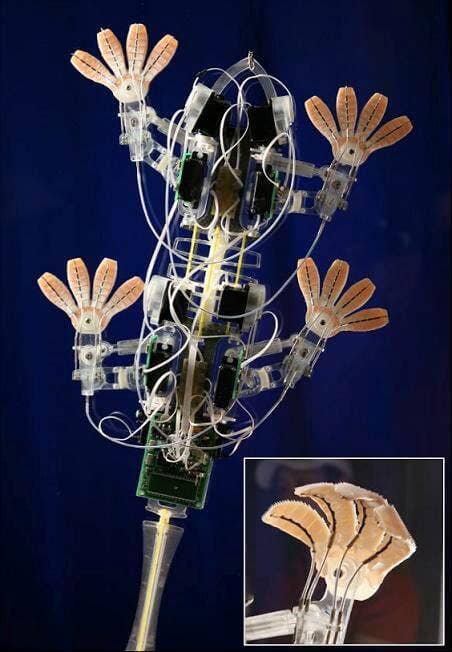StickyBot Mimics Geckos To Climb Walls

Share

The gecko-inspired StickyBot curls its toes to release the dry adhesive that allows it to cling to walls.
When naming robots, I want to encourage all of you researchers to go for the obvious choice, that way we know what we're getting. Case in point: Standford's StickyBot. Giant robotic booger? No, it's a robot that sticks to surfaces and climbs walls like a gecko. In fact, the robot looks almost exactly like a gecko and the adhesive on its padded feet are derived from the tiny hairs the lizards use to cling. Was 'GeckoBot' already taken? My faux outrage hardly matters though, because this wall climbing robot is one of the coolest biology-inspired robots out there. Check out StickyBot in action in the video after the break.
StickyBot's feet are so good at clinging to smooth surfaces that they are used in other Standford robotic projects (as part of RiSE). The dry adhesive technique uses micro-hairs and intramolecular (van der waals) forces to stick bot to wall. Animal inspired robots are nothing new, and we've also seen robots help explain evolutionary biology. Still, when sciences work together, great things happen. Building better robots through biology and better understanding biology through studying robots will quicken advances in both fields. But don't take my word for it. Robert Full, professor at UC Berkeley, gave a great talk at TED 2009 about interconnectivity between biology and robotics.
Be Part of the Future
Sign up to receive top stories about groundbreaking technologies and visionary thinkers from SingularityHub.


Back in 2006, the first StickyBot was named as one of Time Magazine's top inventions of the year, ostensibly as a 'toy'. Now, the Stanford team is building the third iteration of the device, StickyBot III (a better name is TBD). The new robot will have two more degrees of freedom (up to 4) in each leg to allow for better climbing and improved control of adhesion. Hopefully it will be able to navigate on progressively rougher surfaces. No news yet on whether we'll see an active tail like Robert Full discussed.
Full's advocacy for biomutualism is one of the more promising aspects of robots like StickyBot. Climbing walls is cool, don't get me wrong, but mimicking biology is where the real future lies. Nature is a strange, but very inventive designer, and it's had billions of years to perfect biological structures in animals. Using robotics to understand those structures will allow biologists to better understand why organisms developed into their current shapes. Robotics, in turn, can take those shapes and adapt them using materials and intelligence not found in nature. Creations like the hummingbird spybot are a great example. I anxiously await the next generation of biologically inspired robotic organisms. We could have rescue ant-bots, submarines that move like dolphins, or robots that spin silk. Who knows, maybe some of them will even be named correctly.
[photo credit: Standford]
Related Articles

These Robots Are the Size of Single Cells and Cost Just a Penny Apiece

In Wild Experiment, Surgeon Uses Robot to Remove Blood Clot in Brain 4,000 Miles Away

A Squishy New Robotic ‘Eye’ Automatically Focuses Like Our Own
What we’re reading